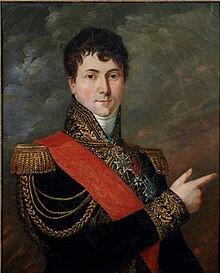Charles Étienne Gudin de La Sablonnière

Charles Étienne Gudin de La Sablonnière (born February 13, 1768 in Montargis , † August 22, 1812 in Smolensk ) was a French infantry general .
Life
Gudin de La Sablonnière came to the military school of Brienne-le-Château as a cadet early on . There he was soon able to distinguish himself and make a career. Enthusiastic about the revolution , he soon became a partisan of Napoleon , whom he had already met at the military school and with whom he was personally friends.
Under the command of General Charles Victoire Emmanuel Leclerc , Gudin de La Sablonnière was a member of the expeditionary army that fought against Toussaint Louverture in 1791 in Saint-Domingue ( Hispaniola ) . In the summer of 1792 he returned to France with his own command.
After further promotions he came to the staff of the Northern Army, and later to the Rhine Army . He fought near Stein, Stockach (May 2, 1800), Messkirch (May 5, 1800), Memmingen (May 10, 1800), Höchstädt (June 19, 1800) and Oberhausen (June 27, 1800).
In the third coalition war Gudin de La Sablonnière was already a general and as such he was able to distinguish himself through bravery in the fourth coalition war . He was seriously wounded in the battle of Jena and Auerstedt (October 14, 1806), but in the same year he took part in the siege of Küstrin .
He fought near Pułtusk (December 26, 1806) and in the battle of Prussian Eylau (February 7/9, 1807).
In the Battle of Wagram (July 5-6, 1809) Gudin de La Sablonnière was seriously wounded again. Nevertheless, he took the side of Marshal Michel Ney on the Russian campaign of the Grande Armée in part. After the Battle of Smolensk (August 17/18, 1812), Gudin was wounded again as commander of the 3rd Division near Walutino on August 19 and died a few days later from his serious injuries. He found his final resting place on the edge of the battlefield. His heart was taken to Paris and buried there in the Père Lachaise cemetery.
His younger brother, Pierre César Gudin des Bardelières , was also a general of the infantry. Gudin de La Sablonnière was married to Jeanne Caroline Creutzer, a sister of General Charles Auguste Creutzer (1780-1832). His son Charles Gabriel Gudin (1798–1874) also made a career in the army.
In November 2019, the remains of Gudin were discovered during excavations on the battlefield near Smolensk and clearly identified by a DNA comparison with those of Gudin's brother Pierre César. The tomb was found based on the exact descriptions in the memoirs of Louis-Nicolas Davout , who organized the funeral.
Honors
- Comte de l'Émpire, June 7, 1808
- Commander of the Military Order of St. Heinrich ( Saxony ), 1808
- Great Eagle of the Legion of Honor , August 14, 1809
- His name can be found on the eastern pillar (16th column) of the triumphal arch on Place Charles-de-Gaulle ( Paris ).
- Louis-Denis Caillouette created a bust of him for the gallery of battles (Prinzenflügel) in the Palace of Versailles
- In his hometown of Montargis, the local police barracks were named "Caserne Gudin" in his honor.
literature
- Karl Bleibtreu : Marshals, generals, soldiers of Napoleon I. VZR-Verlag, Hamburg 1999, ISBN 3-931482-63-4 (reprint of the Berlin edition 1899).
- Kevin F. Kiley: Once there were titans. Napoleon's generals and their battles. 1800-1815 . Greenhill, London 2007, ISBN 978-1-85367-710-6 .
- Charles Mullié: Biography of the célébrités militaires des armées de terre et de mer de 1789 à 1850 . Poignavant, Paris 1851 (2 vol.)
- Stephen Pope: The Cassell dictionary of the Napoleonic wars . Cassell, London 1999, ISBN 0-304-35229-2 .
- Georges Six: Dictionnaire biographique des généraux & amiraux français de la Révolution et de l'Émpire (1792–1814 ), two volumes, Saffroy, Paris 1999, ISBN 2-901541-06-2 , unaltered reprint of the 1934 edition of Paris (PDF / Text file volume 1 and volume 2 )
Web links
Individual evidence
- ↑ a b Mystery of Napoleon's missing general solved in Russian discovery. BBC News, November 6, 2019, accessed November 6, 2019 .
| personal data | |
|---|---|
| SURNAME | Gudin de La Sablonnière, Charles Étienne |
| BRIEF DESCRIPTION | French general of the infantry |
| DATE OF BIRTH | February 13, 1768 |
| PLACE OF BIRTH | Montargis |
| DATE OF DEATH | August 22, 1812 |
| Place of death | Smolensk |

